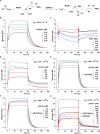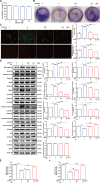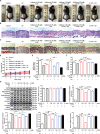Caffeine Targets SIRT3 to Enhance SOD2 Activity in Mitochondria
- PMID: 33015038
- PMCID: PMC7493682
- DOI: 10.3389/fcell.2020.00822
Caffeine Targets SIRT3 to Enhance SOD2 Activity in Mitochondria
Abstract
Caffeine is chemically stable and not readily oxidized under normal physiological conditions but also has antioxidant effects, although the underlying molecular mechanism is not well understood. Superoxide dismutase (SOD) 2 is a manganese-containing enzyme located in mitochondria that protects cells against oxidative stress by scavenging reactive oxygen species (ROS). SOD2 activity is inhibited through acetylation under conditions of stress such as exposure to ultraviolet (UV) radiation. Sirtuin 3 (SIRT3) is the major mitochondrial nicotinamide adenine dinucleotide (NAD+)-dependent deacetylase, which deacetylates two critical lysine residues (lysine 68 and lysine 122) on SOD2 and promotes its antioxidative activity. In this study, we investigated whether the antioxidant effect of caffeine involves modulation of SOD2 by SIRT3 using in vitro and in vivo models. The results show that caffeine interacts with SIRT3 and promotes direct binding of SIRT3 with its substrate, thereby enhancing its enzymatic activity. Mechanistically, caffeine bound to SIRT3 with high affinity (K D = 6.858 × 10-7 M); the binding affinity between SIRT3 and its substrate acetylated p53 was also 9.03 (without NAD+) or 6.87 (with NAD+) times higher in the presence of caffeine. Caffeine effectively protected skin cells from UV irradiation-induced oxidative stress. More importantly, caffeine enhanced SIRT3 activity and reduced SOD2 acetylation, thereby leading to increased SOD2 activity, which could be reversed by treatment with the SIRT3 inhibitor 3-(1H-1,2,3-triazol-4-yl) pyridine (3-TYP) in vitro and in vivo. Taken together, our results show that caffeine targets SIRT3 to enhance SOD2 activity and protect skin cells from UV irradiation-induced oxidative stress. Thus, caffeine, as a small-molecule SIRT3 activator, could be a potential agent to protect human skin against UV radiation.
Keywords: SIRT3; SOD2; UV radiation; antioxidant effects; caffeine; skin photoprotection.
Copyright © 2020 Xu, Gan, Gao, Huang, Wu, Zhang, Wang and Sheng.
Figures





Similar articles
-
SIRT3-SOD2-mROS-dependent autophagy in cadmium-induced hepatotoxicity and salvage by melatonin.Autophagy. 2015;11(7):1037-51. doi: 10.1080/15548627.2015.1052208. Autophagy. 2015. PMID: 26120888 Free PMC article.
-
Protective effect and mechanism of lycium barbarum polysaccharide against UVB-induced skin photoaging.Photochem Photobiol Sci. 2024 Oct;23(10):1931-1943. doi: 10.1007/s43630-024-00642-2. Epub 2024 Oct 8. Photochem Photobiol Sci. 2024. PMID: 39379645
-
Tumour suppressor SIRT3 deacetylates and activates manganese superoxide dismutase to scavenge ROS.EMBO Rep. 2011 Jun;12(6):534-41. doi: 10.1038/embor.2011.65. Epub 2011 May 13. EMBO Rep. 2011. PMID: 21566644 Free PMC article.
-
SIRT3: Oncogene and Tumor Suppressor in Cancer.Cancers (Basel). 2017 Jul 12;9(7):90. doi: 10.3390/cancers9070090. Cancers (Basel). 2017. PMID: 28704962 Free PMC article. Review.
-
SOD1, an unexpected novel target for cancer therapy.Genes Cancer. 2014 Apr;5(1-2):15-21. doi: 10.18632/genesandcancer.4. Genes Cancer. 2014. PMID: 24955214 Free PMC article. Review.
Cited by
-
Caffeine as a Factor Influencing the Functioning of the Human Body-Friend or Foe?Nutrients. 2021 Sep 2;13(9):3088. doi: 10.3390/nu13093088. Nutrients. 2021. PMID: 34578966 Free PMC article. Review.
-
Insight into the cardioprotective effects of melatonin: shining a spotlight on intercellular Sirt signaling communication.Mol Cell Biochem. 2025 Feb;480(2):799-823. doi: 10.1007/s11010-024-05002-3. Epub 2024 Jul 9. Mol Cell Biochem. 2025. PMID: 38980593 Review.
-
Comprehensive Biosafety Profile of Carbomer-Based Hydrogel Formulations Incorporating Phosphorus Derivatives.Gels. 2024 Jul 18;10(7):477. doi: 10.3390/gels10070477. Gels. 2024. PMID: 39057500 Free PMC article.
-
Effects of Coffee on Sirtuin-1, Homocysteine, and Cholesterol of Healthy Adults: Does the Coffee Powder Matter?J Clin Med. 2022 May 25;11(11):2985. doi: 10.3390/jcm11112985. J Clin Med. 2022. PMID: 35683374 Free PMC article.
-
Dexmedetomidine Ameliorates Hippocampus Injury and Cognitive Dysfunction Induced by Hepatic Ischemia/Reperfusion by Activating SIRT3-Mediated Mitophagy and Inhibiting Activation of the NLRP3 Inflammasome in Young Rats.Oxid Med Cell Longev. 2020 Nov 20;2020:7385458. doi: 10.1155/2020/7385458. eCollection 2020. Oxid Med Cell Longev. 2020. PMID: 34493950 Free PMC article.
References
LinkOut - more resources
Full Text Sources
Research Materials
Miscellaneous

